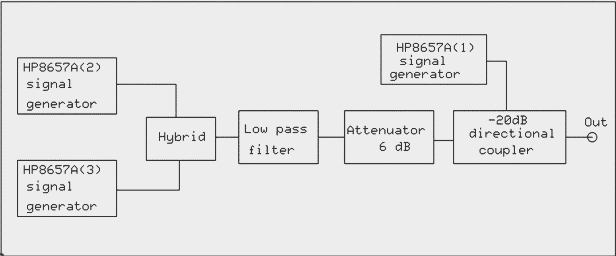
Fig 1. Block diagram for second order intermodulation measurements.
Second order intermodulation requirements.A good receiver needs a dynamic range of about 100 dB according to a study by Peter E. Chadwick, G3RZP HF Receiver dynamic Range: How Much Do We Need? which appeared in the May/June 2002 issue of QEX. This is the requirement for third order intermodulation and the "modest" requirement is due to the fact that the highest IP3 needed, +33 dBm, is not needed simultaneously with a low noise figure.For second order intermodulation it may be different. A wideband antenna with high efficciency might receive signals that are 100 dB above the noise on 7 MHz at times when the noise floor at 14 MHz is much lower than the noise floor on 7 MHz and therefore a second order intermodulation-free dynamic range of 110 dB might be needed. For a noise figure of 20 dB on 14 MHz corresponding to a noise floor of -130 dBm in SSB bandwidth (2.4 kHz) it means that two signals at -20 dBm are allowed to produce second order intermodulation at -130 dBm. The corresponding value for IP2 is +90 dBm. In a multi-band, multi-operator station, second order intermodulation requirements may be much higher. Selective antennas, external band pass filters and attenuators can be used to increase IP2 for the RXHFA as well as for any other receiver. Measuring second order intermodulationSecond order intermodulation is much easier to measure than third order intermodulation because the frequencies of two strong signals are well separated from the frequency of the intermodulation product. Fig.1. shows a suitable arrangement. |

Fig 1. Block diagram for second order intermodulation measurements. |
|
To find out how good the low pass filter has to be one can make a measurement without any filter to see how strong overtones and intermodulation products are. Figure 2 shows such a measurement with the level of generators 2 and 3 set to +9 dBm to provide 0 dBm at the input of the RXHFA unit. The level of generator 1 is set to 42 dBm to provide a signal level of -68dBm at the RXHFA input which is equal to the second order intermodulation product. |
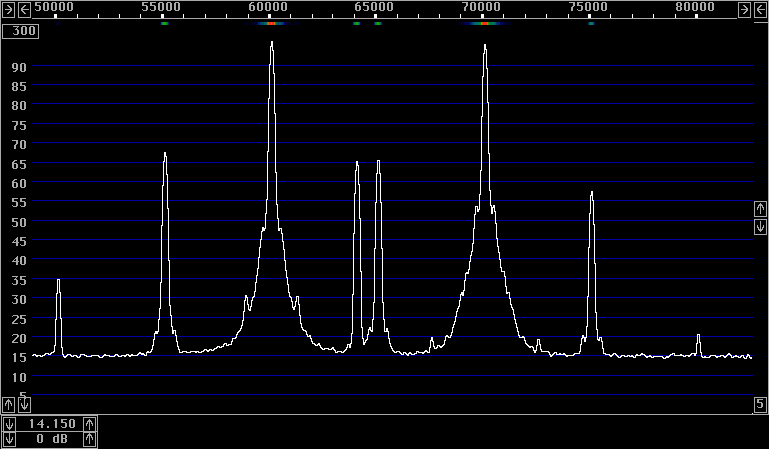
Fig 2. Three generators fed into Linrad as shown in fig. 1 but without any low pass filter. Generators 2 and 3 are at 7.080 and 7.085 MHz respectively with a power level of 0 dBm for each signal. The second order intermodulation product (the sum frequency) is at 14.165. Generator 1 is at 14.164 MHz with a power level of -68 dBm. |
|
The IP2 value deduced from the data of fig. 2 would be +68 dBm but the sum frequency is generated inside the signal generators so it is not the IP2 of the RXHFA unit. The low pass filter (or notch filter) to use for this measurement would have to attenuate by about 50 dB to allow measurements of IP2 in the order of +90 dBm if the intermodulation within the generators were the same as without any filter. The filter may affect the impedance seen by the hybrid and therefore the isolation may change so it is a good idea to make the filter a little better. Something like 80 dB should be perfectly adequate. A low pass filter to use for IM2 measurements can be designed with simple standard inductors. Fig 3 shows a filter with much higher attenuation than needed for this measurement. |

Fig 3. A low pass filter made from standard inductors. |
|
A network analyzer such as the HP8712C is by far not good enough to see the response of a filter like this. A Tektronix 2753P with a tracking generator and a power amplifier to boost the signal level to +30 dBm makes it possible to see the filter characteristics. Fig. 4 and 5 together show that 7 MHz signals are attenuated by about 140 dB which is very much more than needed for IM2 measurements. |

Fig 4. Frequency response of the filter in figure 3. |
|
|
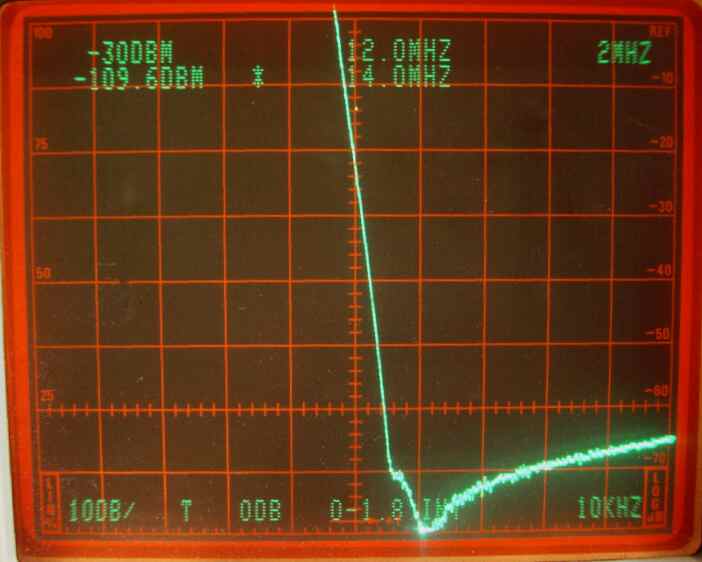
Fig 5. Same as fig.4 but with 60 dB higher sensitivity on the spectrum analyzer. |
When the low pass filter is inserted, the Linrad screen looks quite different as can be seen in fig. 6. |
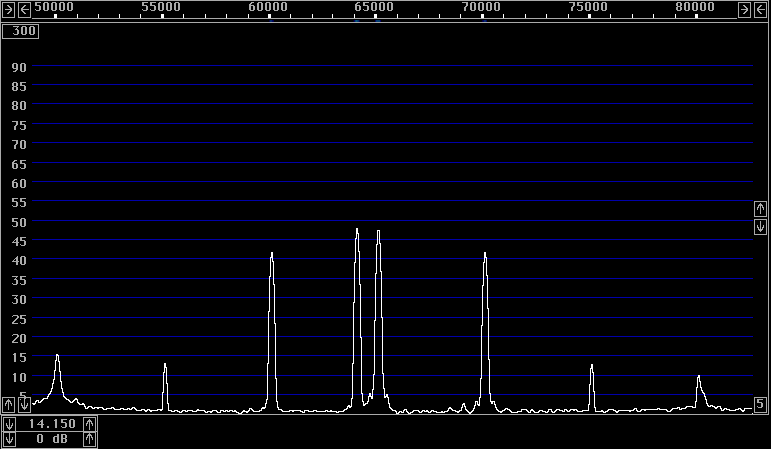
Fig 6. Three generators fed into Linrad as shown in fig. 1. Generators 2 and 3 are at 7.080 and 7.085 MHz respectively with a power level of 0 dBm for each signal. The second order intermodulation product (the sum frequency) is at 14.165. Generator 1 is at 14.164 MHz with a power level of -86 dBm. |
|
IP2 as deduced from fig.6 is +86 dBm. It is close, but not quite correct because input signals of 0 dBm are a little too strong to still be on the second order curve as will be shown below. If the 6 dB attenuator is removed and generators 2 and 3 is readjusted to still give a signal level of 0 dBm at the RXHFA input, the IP2 value becomes +75 dBm which is not correct. The reason is that without the 6 dB pad the RXHFA does not see 50 ohms at 14 MHz. The two 7 MHz signals come from a 50 ohm source, but the 14 MHz second order intermodulation that is generated in the input switch of the RXHFA unit looks into a VSWR of 22:1 and this causes the level to be much higher than it would be in real life with a real antenna connected. A real antenna would be close to 50 ohms on 14 MHz. When the RXHFA unit is set to 14 MHz the input is well matched to 50 ohms on 14 MHz, but on 7 MHz the input VSWR is about 20:1. It may be possible for a 14 MHz antenna to have a very high VSWR on 7 MHz and to accidentally match the input impedance of the RXHFA on 7 MHz thus providing much more signal compared to what it would give in a matched load. Such phenomena might degrade the second order intermodulation free dynamic range. Should it happen, the solution is an attenuator at the RXHFA input. An attenuator will define the impedance and make VSWR close to 1 on all frequencies. It will degrade the noise figure by the amount of attenuation but that can be compensated by the RXHFA gain control. An attenuator will not only make impedances correct. It will also increase IP2. Verifying IM2 measurementsBecause of the extremely high isolation between the generators and the test object that is provided by the low pass filter it is fairly easy to verify the IM2 measurement. Adding some attenuation at the output of the hybrid should change the IM2 level by exactly the same amount as adding the same attenuator at the RXHFA input. This is contrary to a conventional IM3 measurement (without a notch filter) because different placements of an attenuator would change the isolation between the signal generators and therefore one could easily draw the wrong conclusions at low intermodulation levels in an IM3 measurement.The filter contains standard inductors from Epcos (formerly Siemens). These inductors are iron-free and should not produce any intermodulation. To verify the IP2 measurement on the RXHFA unit, the levels of the sum frequency and of the second order harmonic were measured with a stepped attenuator inserted between the low pass filter and the 6 dB attenuator. 2 W amplifiers were added to the generators 2 and 3 to allow for more attenuation. Two series of measurements were made. One with a 20 dB attenuator in front of the bandpass filter and one without, i.e. with a 20 dB higher signal level inside the band pass filter. The result is presented in table 1 and table 2. |
Att | 7MHz (each signal) | Sum frequency | Second harmonic
setting | RXHFA Filter | RXHFA Filter | RXHFA Filter
| input output | input output | input output
(dB) | (dBm) (dBm) | (dBm) (dBm) | (dBm) (dBm)
0 +3 +3 -73.5 -73.5 -72.5 -72.5
1 +2 +3 -84.2 -83.2 -86.7 -85.7
2 +1 +3 -85.2 -83.2 -91.7 -89.7
3 0 +3 -87.3 -84.3 -93.1 -90.1
4 -1 +3 -90.2 -86.2 -95.8 -91.8
5 -2 +3 -93.1 -88.1 -98.7 -93.7
10 -7 +3 -106.3 -96.3 -111.7 -101.7
15 -12 +3 -116.6 -101.6 -122.9 -107.9
20 -17 +3 -126.8 -106.8 -133.2 -113.2
Table 1 Levels of singnals and second order products with
different settings of a stepped attenuator. See text. |
Att | 7MHz (each signal) | Sum frequency | Second harmonic
setting | RXHFA Filter | RXHFA Filter | RXHFA Filter
| input output | input output | input output
(dB) | (dBm) (dBm) | (dBm) (dBm) | (dBm) (dBm)
20 +3 +23 -79.8 -59.8 -80.4 -60.4
21 +2 +23 -94.7 -73.7 -96.5 -75.5
22 +1 +23 -92.5 -70.5 -99.3 -77.3
23 0 +23 -93.4 -70.4 -99.3 -76.3
24 -1 +23 -95.2 -71.2 -100.9 -76.9
25 -2 +23 -97.0 -72.0 -102.9 -77.9
30 -7 +23 -105.8 -75.8 -111.6 -81.6
35 -12 +23 -113.4 -78.4 -119.1 -84.1
40 -17 +23 -119.5 -79.5 -125.6 -85.6
45 -22 +23 -125.7 -80.7 -130.9 -85.9
50 -27 +23 -130.7 -80.7 -
Table 2 Levels of singnals and second order products with
different settings of a stepped attenuator. See text.An inspection of table 2 shows that the level of the sum frequency referenced to the filter output flattens out at -80.7 dBm when the signal level is +23 dBm. This means that the output IP2 of the filter is about +104 dBm. The source of this intermodulation is unknown. The level of the sum frequency shows a good second order behaviour in table 1 for signal levels below -5 dBm. The input IP2 of the RXHFA unit is about +92 dBm. The maximum signal level at the RXHFA input should not exceed -2 dBm for each of a pair of two signals because intermodulation grows rapidly above this level. It means that the peak power summed from all signals at the input should not exceed + 4 dBm. The J310 switch is layout criticalThe data presented above is with the 4.7 megohm gate resistor mounted in the air above the PCB as shownin fig. 7. |
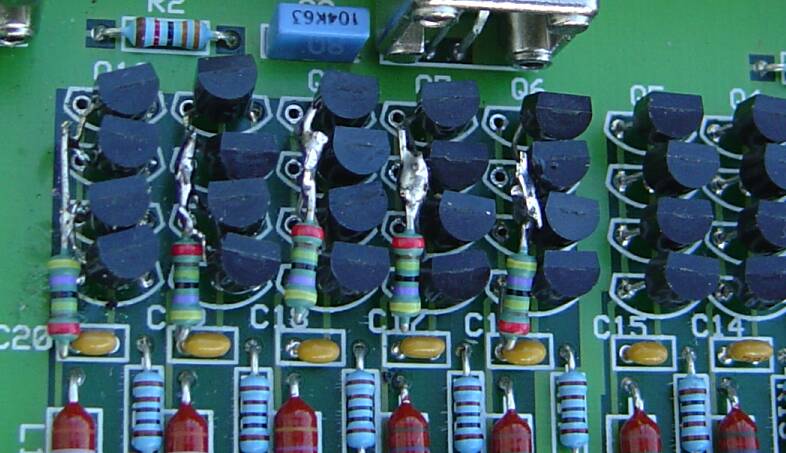
Fig 7. Stray capacitances from the gates of the switch transistors to ground degrade second order intermodulation seriously. By mounting the gate resistors as shown here for channel 1 a good input IP2 of +92 dBm is obtained. If the resistors are mounted on the PCB about 6 cm away from the transistors as in channel 2 in this photo, the stray capacitances degrade IP2 to about +65 dBm. |
|
The high stray capacitances at the J310 gates is a PCB layout mistake. If the gate resistor had been placed next to the transistors, the stay capacitances might have been low enough to allow the gate resistor to be mounted on the PCB. As low capacitances as with the mounting shown in fig.7 would not have been possible though. |